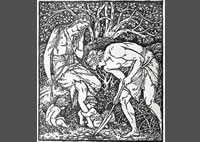Standing at the outset of the whole Bible, Gen 1:1-2:3 is one of the Bible’s most influential descriptions relating to God, the universe, and the role of humanity in the cosmos. The God we see here is a cosmic king, functioning (as many ancient kings did) as both supreme commander and high priest. The text depicts the universe as a cosmic temple over which God presides and in which God offers God’s blessing. Within this context humans are depicted as earthly replicas of God (made in God’s “image and likeness”), reflecting God’s sovereign and creative power in the way that they “rule” over creation and themselves create children. It is not a scientific account of the origins of the universe, nor can it be made compatible with contemporary science. Instead, it is a story by theologians, meant to show God’s ultimate power over the universe and the ways in which humans share that power.
Does Genesis 1 describe creation “out of nothing”?
The first verse of Gen 1 is usually translated “in the beginning when God created heaven and earth,” and most people picture God conjuring parts of the universe like a magician: “Let there be … and it was so.” But historical research suggests that the traditional translation is wrong. Instead, the first two verses of the Bible describe the chaos that preceded God’s creative ordering of the cosmos: “when God first created the heaven and the earth—and the earth was a formless void, darkness was on the face of the deep, and a divine wind hovered over the waters—God said ….” In the beginning, so to speak, was chaos.
The rest of Gen 1 then describes how God transforms that dark chaos into an ordered, inhabited, “very good” cosmos. God creates light first, and this helps ground the pattern of day and night that dominates the rest of the chapter. On day two, God creates a dome (often translated “firmament”) that creates an air bubble between the upper and lower primal oceans, in which the rest of creation can flourish. Day three brings the creation of dry land and God’s command for that dry land to spring forth with plants. The next three days each correspond to one of the first three: God creates heavenly lights on day four, corresponding to light on day one; God creates sea and air creatures on day five to inhabit the realms focused on in day two; and God creates animals and humans on day six to inhabit the dry land created on day three and to eat the plants that sprung forth then. Throughout, God speaks commands like a royal ruler, and God’s commands are executed, marked by notices such as “and it was so.” Then, God looks on God’s work and pronounces that “it is good.” Indeed, after creating animals and humanity on the sixth day, God proclaims the inhabited cosmos to be “very good.” If there is one message that Gen 1 wants to give about God and the universe, it is that God is in charge and the world that God ordered is “very good.” Note here that the emphasis throughout the chapter is on God’s power to organize creation into the different parts of a cosmic temple, not God’s magical “creation” of matter out of nothing. The main idea is the goodness of creation and humanity’s role in it.
Can the word ‘day’ in Genesis 1 also mean ‘era’?
Some people have suggested that Gen 1 can be made compatible with modern science if one understands the word “day” in the story to refer to an “era” potentially spanning thousands or even hundreds of thousands of years. What these readers miss is that the whole six-day structure of Gen 1 leads to a conclusion based on an actual week: God’s rest (Hebrew shabbat) on and blessing of the seventh day (Gen 2:1-3). No other ancient creation account is organized this way. Some describe the gods resting after creation, but only because they had created humans to do their work for them. Gen 1 is unique in describing creation as a seven-day process crowned by God’s establishment of a weekly holiday on which not just God but eventually humans as well are to rest (for example, Exod 20:8-11, Exod 31:12-17). This Sabbath rest is not a burden but another way that humans can reflect God’s “image and likeness.” Thus to reinterpret the “days” of Gen 1:1-2:3 as metaphorical “eras” or the like is to miss the whole emphasis of this story on God’s introduction of a Sabbath rest in the week we all know.
Bibliography
- Levenson, Jon D. Creation and the Persistence of Evil: The Jewish Drama of Divine Omnipotence. San Francisco: Harper & Row, 1988.
- Clifford, Richard J. Creation Accounts in the Ancient Near East and in the Bible. Washington, D.C.: Catholic Biblical Association of America, 1994.
- Smith, Mark S. The Priestly Vision of Genesis 1. Minneapolis: Fortress, 2010.





